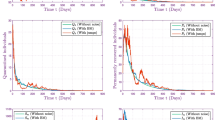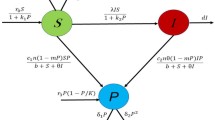Summary
A continuous-time density dependent model was constructed of a species with a two stage life cycle. This model has a unique stable equilibrium. With the introduction of steriles at constant rate a second positive unstable steady state appears; this condition does not depend on the mode of action within the life cycle of the density dependence or its relative strength.
A comparison was made of the effects of having the density dependence in each of larval and adult recruitment and larval and adult losses. It was found that if only adult recruitment is denisty dependent, then adult numbers can actually increase with the release of steriles provided density independent recruitment greatly exceeds density independent losses. Sterile releases were often more effective against larvae than against adults, although in some cases not importantly so.
Density dependence in recruitment gives much lower equilibrium values than when density dependence of comparable strength is in the mortality.
The release rates needed to cause extinction were generally between 0.1 and 0.5 of the larval equilibrium with no sterile releases except when the density dependence is predominantly in adult recruitment, in which case much higher release rates are required.
Similar content being viewed by others
References
Berryman, A. A., T. P. Bogyo, andL. C. Dickmann (1973) Computer simulation of population reduction by release of sterile insects: II. The effects of dynamic survival and multiple mating. InComputer models and application of the sterile-male technique. International Atomic Energy Agency, Vienna.
Hahn, W. (1967)Stability of motion. trans.A. Baartz. Springer-Verlag, New York.
Itô, Y. (1977) A model of sterile insect release for eradication of the melon fly,Dacus cucurbitae Coquillett.Appl. Ent. Zool. 12: 303–312.
Knipling, E. F. (1955) Possibilities of insect control or eradication through the use of sexually sterile males.J. Econ. Ent. 48: 459–462.
Knipling, E. F. (1972) Sterilization and other genetic techniques. InPest control: strategies for the future. National Academy of Sciences, Washington.
Lack, D. (1954)The natural regulation of animal numbers. Clarendon press, Oxford.
Miller, D. R. andD. E. Weidhaas (1974) Equilibrium populations during a sterile-male release program.Environ. Entomol. 3: 211–216.
Proverbs, M. D. (1974) Ecology and sterile release programs, the measurement of relevant population processes before and during release and the assessment of results. 201–223. InR. Pal andM. J. Whitten (eds.)The use of genetics in insect control. Elsevier, North-Holland.
Prout, T. (1978) The joint effects of the release of sterile males and immigration of fertilized females on a density regulated population.Theor. Popul. Biol. 13: 40–71.
Weidhaas, D. E. (1963) Field development and evaluation of chemosterilants 275–314. InG. C. LaBrecque andC. N. Smith (eds.)Principles of insect chemosterilization. Appleton-Century-Crofts, New York.
Whitten, M. J. andG. G. Foster (1975) Genetical methods of pest control.Annual Review of Entomology 20: 461–476.
Whitten, M. J. andR. Pal (1974) Introduction. 1–16. InR. Pal andM. J. Whitten (eds.)The use of genetics in insect control. Elsevier, North-Holland.
Author information
Authors and Affiliations
Rights and permissions
About this article
Cite this article
Barclay, H.J. The sterile insect release method on species with two-stage life cycles. Res Popul Ecol 21, 165–180 (1980). https://doi.org/10.1007/BF02513619
Issue Date:
DOI: https://doi.org/10.1007/BF02513619




